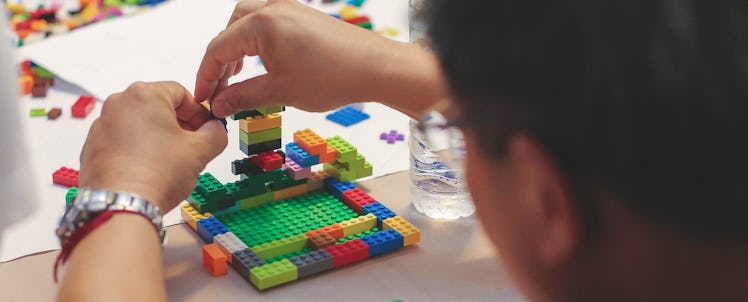Building Legos by Myself Makes Me a Better Parent
It's fun to be a kid sometimes.

Dave Racine is a dad of two boys, ages 5 and 2. He lives in Milwaukee, Wisconsin, and runs his own PR company. About a year ago, he bought his older son, Nobel, a Lego set. Nobel loved it, but so did Dave. One night, when his son had finished playing, Dave started building his own creations. Here, Dave explains how Legos help him react authentically — and connect with his kids in the process.
When I had my two sons, my life went from thinking about myself and my wife, to being really into being a dad. It’s fundamentally changed who I am and how I see the world, which is ironic, because now I unwind with their toys, the same ones I used to play with as a kid.
My kids are very active. From the minute Nobel came out of the womb, I don’t think he slept at all for the first five and a half months. He was this colicky kid who was very high-need. Now, he’s spirited, always on the go. Doesn’t like the idea of napping and doesn’t know when he’s tired — by the early afternoon or late afternoon, that’s just a nightmare.
Welcome to “How I Stay Sane,” a weekly column in which real dads talk about the things they do to stay grounded. It’s easy to feel strung out as a parent, but the dads we feature recognize that unless they regularly take care of themselves, the parenting part of their lives will get a lot harder. The benefits of having that one “thing” are enormous.
About a year ago, we introduced him to the smaller Lego toys. It’s kind of one of those things where, like, you sit down and at first, you’re just stacking them for no reason. Now we make little cars or police trucks and all sorts of other stuff. If he sees a fire truck from down the street, he’ll try to build it.
I’m a person who is generally on the go, too. But at 8:30 at night, when I finally have time to myself, I’ll go into the playroom, do some clean-up, and build Legos. I just find that for me to be truly happy, I can’t just chill out. I have to be a little bit stimulated by something. So I think walking into an empty playroom and turning off the overhead lights and putting things back at the same time as I assemble something became a good ease of mind. I find a real sense of calm that eases my spirit.
The first time I started playing with Legos, I had just gone into the playroom to clean up. I found myself picking up things and sorting them, and then I was kind of like, “Oh, I’m spending my quiet time working. Maybe I can just sit down here cross-legged and put something together.” It felt like a little tunnel back to my own childhood.
Another benefit: Nobel just finished kindergarten. I’ve been trying to find ways to connect and talk and things like that. And I do need to quiet my mind by staying busy, as paradoxical as that is. So at night, I’ll go into the playroom and put something together.
When he wakes up in the morning and goes into his playroom, he finds a new creature or a building or a car or a truck. He’s up before me — he’ll run into my bedroom and say, “Oh, I love what you made!” Then we have another really good opportunity to connect and I can tell him why I made it. It really just is about connecting and talking.
So it’s a double-edged sword with me. I legitimately think of Lego-building as a way to spend an hour unwinding. But it is also an opportunity to reconnect several hours later.
And working in marketing, my job is to sit back and be the audience and think of it like that audience group. As a 40-year-old, putting together a Lego car, I want to make it look like a race car. But kids are into totally different things, and see the world totally differently. So the wheels might not end up where you’d put them or the driver’s seat might be backward. Kids just have a different way of looking at stuff. I want to honor that for Nobel.
When you know what rules to follow, life is easy. Cross at the sidewalk. Say hello to people. We built this network of rules, and that makes life easy. When kids know the rules, that’s good. But when there’s an opportunity as an adult to break a rule, you should. Somewhere along the line we develop these constructs that things must match and go a certain way. But for me to sit back and ask myself, ‘Okay, what wild thing wouldn’t I normally do? What wouldn’t Dave do? How am I going to get a reaction out of Nobel and his brother on something?’ is really fun.
It’s nice to just go free-form, and not even have an end result in mind. To just think: What story am I going to tell my kids when this thing is completed?